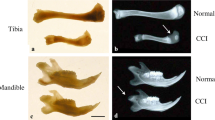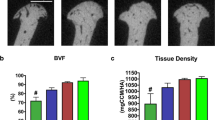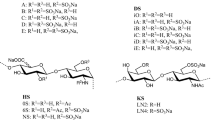Abstract
There is little information available regarding the morphological and biomolecular characteristics of mandibular condylar cartilage. The purpose of this study was to determine the age-related changes in the morphology and immunolocalization of glycosaminoglycans (GAGs) in mandibular condyles. The mandibular condylar cartilages from 4-, 8-, 16-, 32-, and 64-week-old Wistar male rats were examined to verify the localization of chondroitin-4-sulfate (Ch-4S), chondroitin-6-sulfate (Ch-6S) and keratan sulfate (KS) using an indirect immunofluorescent technique with three monoclonal antibodies for glycosaminoglycans, 2-B-6, 3-B-3 and 5-D-4, respectively. Morphologically, the condylar cartilage was a growth cartilage during growing periods, began to differentiate into articular cartilage from the central area of 16-week-old condyles, and became mature articular cartilage at 32 weeks of age. A regional difference was found in the morphological features and distribution of GAGs between the anterior, central, postero-superior and posterior areas of the condyles at each age. The immunohistochemical localizations of these three glycosaminoglycans showed age-related, morphology-dependent changes, from growth cartilage to articular cartilage-like cartilage. Immunoreactions for all of the antibodies decreased progressively with age in the interterritorial matrix, while the pericellular and territorial matrix in the condylar cartilage of the mandible maintained relatively higher immunoreactivity. In conclusion, age-related and regional differences in the localization of glycosaminoglycans Ch-4S, Ch-6S, and KS were found in the mandibular condyles in rats, and these changes are believed to be related to functional and developmental requirements.
Similar content being viewed by others
References
Byers S, Caterson B, Hopwood IT, Fosterk BK (1992) Immunolocation analysis of glycosaminoglycans in the human growth plate. J Histochem Cytochem 40:275–282
Caterson B, Christner JE, Baker JR (1983) Identification of a monoclonal antibody that specifically recognizes corneal and skeletal keratan sulfate. Monoclonal antibodies to cartilage proteoglycan. J Biol Chem 258:8848–8854
Copray JCVM, Liem RSB (1989) Ultrastructural changes associated with weaning in the mandibular condyle in the rat. Acta Anat 134:35–47
Copray JCVM, Jansen HWB, Duterloo HS (1985) Effects of compressive forces on proliferation and matrix synthesis in mandibular condylar cartilage of the rat in vitro. Arch Oral Biol 30:299–304
Couchman JR, Caterson B, Christner JE, Baker JR (1984) Mapping by monoclonal antibody detection of glycosaminoglycans in connective tissue. Nature 307:650–652
Durkin JF, Heeley JD, Irving JT (1973) Oral sciences review, 2. Villadsen & Christensen Munksgaard, Copenhagen, pp 29–99
Enlow DH (1962) A study of the postnatal growth and remodeling of bone. Am J Anat 110:79–101
Franzen A, Inerot S, Hejderup S-O, Heinegard D (1981) Variations in the composition of bovine articular cartilage with distance from the articular surface. Biochem J 195:535–543
Furusawa M (1995) Immunohistochemical study on changes in the extracellular matrix during development of rat articular cartilage. Jpn J Oral Biol 37:37–49
Gillard CG, Reilly HC, Bell-Booth PG, Flint MH (1979) The influence of mechanical forces on the glycosaminoglycan content of the rabbit flexor digitorum profundus tendon. Connect Tissue Res 7:37–46
Goret-Nicaise M, Dhem A (1987) Electron microscopic study of chondroid tissue in the cat mandible. Calcif Tissue Int 40:219–223
Hall BK (1972) Immobilization and cartilage transformation into bone in the embryonic chick. Anat Rec 173:391–404
Higuchi Y, Gonda Y (1991) Histochemical observation on the glycosaminoglycans in the head of the rat mandible. J Jpn Prothodont Soc 35:757–764
Hiiemae K (1971) The structure and function of the jaw muscles in the rat (Rattus norvegicus L.), III. The mechanics of the muscles Zool J Linn Soc 50:111–132
Kantomaa T, Hall BK (1990) Mechanisms of adaptation in the mandibular condyle of the mouse, An organ culture study. Acta Anat 132:114–119
Koike H, Ejiri S, Hanada K, Ozawa H (1995) Age-related histological changes in rat mandibular condyle. J Bone Miner Metab 13:10–16
Koski K (1974) The mandibular complex. Trans Eur Orthod Soc: 53–67
Livne E, Mark K von der, Silbermann M (1985) Morphologic and cytochemical changes in maturating and osteoarthrotic articular cartilage in temporomandibular joint of mice. Arthritis Rheum 28:1027–1038
Loeser RF (1993) Integrinmediated attachment of articular chondrocytes to extracellular matrix proteins. Arthritis Rheum 36:1103–1110
Luder HU, Leblond CP, Mark K von der (1988) Cellular stages in cartilage formation as revealed by morphometry, radiography and type II collagen immunostaining of the mandibular condyle from weanling rats. Am J Anat 182:197–214
Mark K von der (1980) Immunological studies on collagen type transition in chondrogenesis. Curr Top Dev Biol 14:199–225
Mark K von der, Mark H von der, Gay S (1976) Study of differential collagen synthesis during development of chick embryo by immunofluorescence. Localization of type I and type II collagen during long bone development. Dev Biol 53:153–170
Mizoguchi I, Nakamura M, Takahashi I, Kagayama M, Mitani H (1990) An immunohistochemical study of localization of type I and type II collagens in mandibular condylar cartilage. Histochemistry 93:593–599
Mizoguchi I, Nakamura M, Takahashi I, Kagayama M, Mitani H (1992) A comparison of the immunolocalization of type I and type II collagens in craniofacial cartilages of the rat. Acta Anat 144:59–64
Mizoguchi I, Nakamura M, Takahashi I, Sasano Y, Kagayama M, Mitani H (1993) Presence of chondroid bone on rat mandibular condylar cartilage, An immunohistochemical study. Anat Embryol 187:9–15
Petrovic A (1974) Control of the postnatal growth of secondary cartilages of the mandible by mechanisms regulating occlusion, cybernetic model. Trans Eur Orthod Soc: 69–75
Poole AR, Pidoux I, Reiner A, Choi H, Rosenberg LC (1984) Association of an extracellular protein (chondrocalcin) with the calcification of cartilage in endochondral bone formation. J Cell Biol 98:54–65
Sasano Y, Mizoguchi I, Furusawa M, Aiba N, Ohtani E, Iwamatsu Y, Kagayama M (1993) The process of calcification during development of the rat tracheal cartilage characterized by distribution of alkaline phosphatase activity and immunolocalization of types I and II collagens and glycosaminoglycans. Anat Embryol 188:31–39
Silbermann M, Reddi AR, Hand RD, Leapman RD, Mark K von der, Franzen A (1987) Further characterization of the extracellular matrix in the mandibular condyle in neonatal mice. J Anat 151:169–188
Simon MR (1977) The role of compressive forces in the normal maturation of the condylar cartilage in the rat. Acta Anat 97:351–360
Sorrell JM, Lintala AM, Mahmoodian F, Caterson B (1988) Epitope-specific changes in chondroitin sulfate/dermatan sulfate proteoglycans as markers in the lymphopoietic and granulopoietic compartments of developing bursae of fabricius. J Immunol 40:4263–4270
Takahashi I (1991) A histological study of the effect of the lateral pterygoid muscle activity on the growth of rat mandibular condylar cartilage. J Jpn Orthod Soc 50:368–382
Takahashi I, Mizoguchi I, Nakamura M, Kagayama M, Mitani H (1995a) Effects of lateral pterygoid muscle hyperactivity on differentiation of mandibular condyles in rats. Anat Rec 241:328–336
Takahashi I, Mizoguchi I, Sasano Y, Saitoh S, Kagayama M, Mitani H (1995b) Effects of electrical stimulation of the lateral pterygoid muscle on the localization of glycosaminoglycans in mandibular condyles in rats. J Jpn Orthod Soc 54:402–412
Toole BP (1983) Glycosaminoglycans in morphogenesis. In: Hay ED (ed) Cell biology of the extracellular matrix. Plenum Press, New York, pp 259–294
Weijs WA (1976) Morphology of the muscles of mastication in the albino rat, Rattus norvegicus (Berkenhout, 1976). Acta Morphol Neerl-Scand 11:321–340
Wight TN, Heinegard DK, Hascall VC (1991) Proteoglycans structure and function. In: Hay ED (ed) Cell biology of the extracellular matrix, 2nd edn. Plenum Press, New York, pp 45–78
Author information
Authors and Affiliations
Rights and permissions
About this article
Cite this article
Takahashi, I., Mizoguchi, I., Sasano, Y. et al. Age-related changes in the localization of glycosaminoglycans in condylar cartilage of the mandible in rats. Anat Embryol 194, 489–500 (1996). https://doi.org/10.1007/BF00185995
Accepted:
Issue Date:
DOI: https://doi.org/10.1007/BF00185995




